Business Foundations: Leadership, Motivation, and Wholesale
VerifiedAdded on 2022/11/30
|7
|1798
|123
Report
AI Summary
This report delves into the core foundations of business, exploring various leadership styles such as autocratic, democratic, and situational leadership, and their impact on employee motivation. It examines prominent motivational theories, including Maslow's hierarchy of needs and Vroom's expectancy theory, providing insights into how organizations can effectively inspire and engage their workforce. Furthermore, the report analyzes the distinctions between wholesale and retail businesses, highlighting their operational differences, investment requirements, and the impact of digitalization on their respective models. The report also references academic sources to support its findings. This report is a valuable resource for students studying business foundations and related topics.
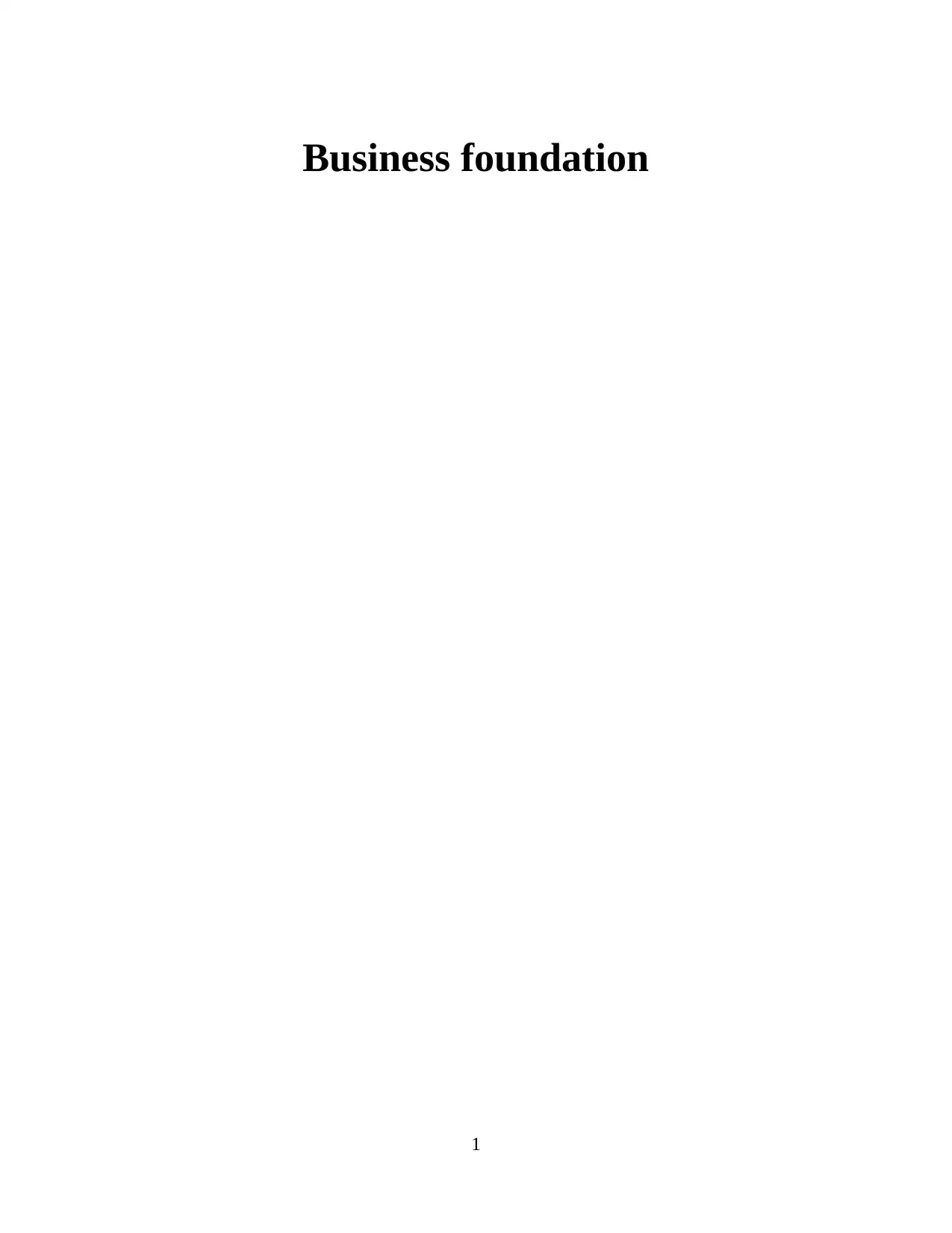
Business foundation
1
1
Paraphrase This Document
Need a fresh take? Get an instant paraphrase of this document with our AI Paraphraser
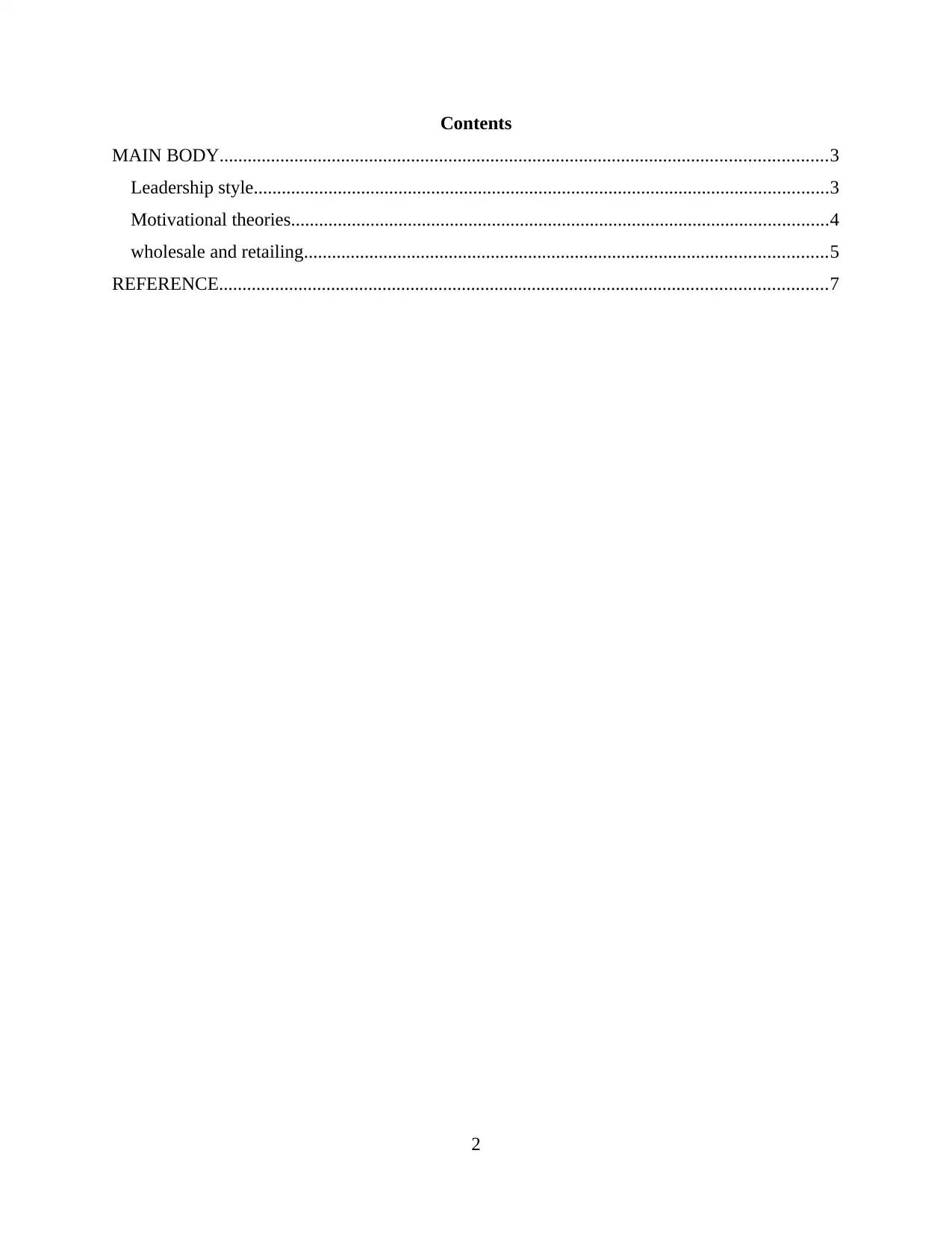
Contents
MAIN BODY..................................................................................................................................3
Leadership style...........................................................................................................................3
Motivational theories...................................................................................................................4
wholesale and retailing................................................................................................................5
REFERENCE..................................................................................................................................7
2
MAIN BODY..................................................................................................................................3
Leadership style...........................................................................................................................3
Motivational theories...................................................................................................................4
wholesale and retailing................................................................................................................5
REFERENCE..................................................................................................................................7
2
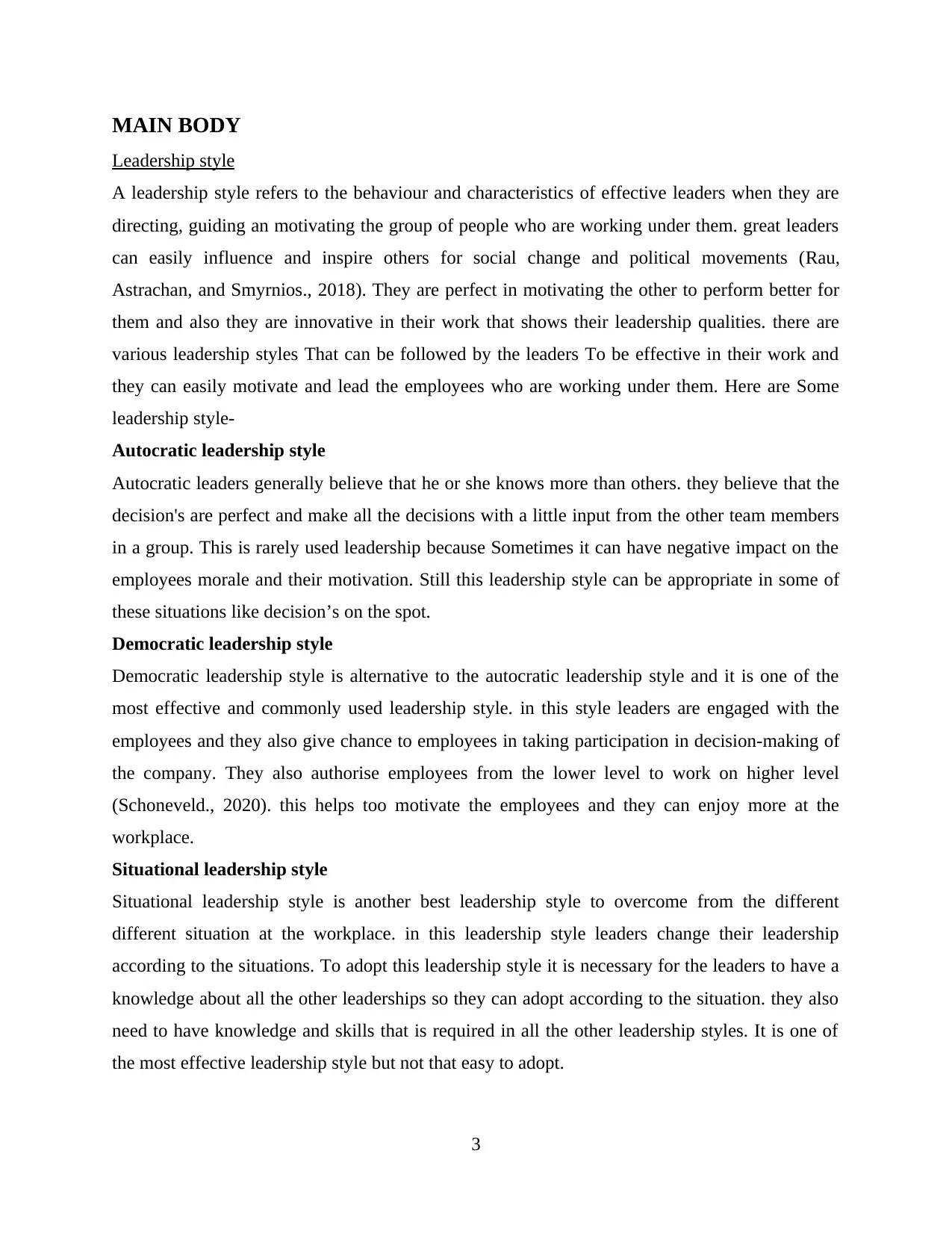
MAIN BODY
Leadership style
A leadership style refers to the behaviour and characteristics of effective leaders when they are
directing, guiding an motivating the group of people who are working under them. great leaders
can easily influence and inspire others for social change and political movements (Rau,
Astrachan, and Smyrnios., 2018). They are perfect in motivating the other to perform better for
them and also they are innovative in their work that shows their leadership qualities. there are
various leadership styles That can be followed by the leaders To be effective in their work and
they can easily motivate and lead the employees who are working under them. Here are Some
leadership style-
Autocratic leadership style
Autocratic leaders generally believe that he or she knows more than others. they believe that the
decision's are perfect and make all the decisions with a little input from the other team members
in a group. This is rarely used leadership because Sometimes it can have negative impact on the
employees morale and their motivation. Still this leadership style can be appropriate in some of
these situations like decision’s on the spot.
Democratic leadership style
Democratic leadership style is alternative to the autocratic leadership style and it is one of the
most effective and commonly used leadership style. in this style leaders are engaged with the
employees and they also give chance to employees in taking participation in decision-making of
the company. They also authorise employees from the lower level to work on higher level
(Schoneveld., 2020). this helps too motivate the employees and they can enjoy more at the
workplace.
Situational leadership style
Situational leadership style is another best leadership style to overcome from the different
different situation at the workplace. in this leadership style leaders change their leadership
according to the situations. To adopt this leadership style it is necessary for the leaders to have a
knowledge about all the other leaderships so they can adopt according to the situation. they also
need to have knowledge and skills that is required in all the other leadership styles. It is one of
the most effective leadership style but not that easy to adopt.
3
Leadership style
A leadership style refers to the behaviour and characteristics of effective leaders when they are
directing, guiding an motivating the group of people who are working under them. great leaders
can easily influence and inspire others for social change and political movements (Rau,
Astrachan, and Smyrnios., 2018). They are perfect in motivating the other to perform better for
them and also they are innovative in their work that shows their leadership qualities. there are
various leadership styles That can be followed by the leaders To be effective in their work and
they can easily motivate and lead the employees who are working under them. Here are Some
leadership style-
Autocratic leadership style
Autocratic leaders generally believe that he or she knows more than others. they believe that the
decision's are perfect and make all the decisions with a little input from the other team members
in a group. This is rarely used leadership because Sometimes it can have negative impact on the
employees morale and their motivation. Still this leadership style can be appropriate in some of
these situations like decision’s on the spot.
Democratic leadership style
Democratic leadership style is alternative to the autocratic leadership style and it is one of the
most effective and commonly used leadership style. in this style leaders are engaged with the
employees and they also give chance to employees in taking participation in decision-making of
the company. They also authorise employees from the lower level to work on higher level
(Schoneveld., 2020). this helps too motivate the employees and they can enjoy more at the
workplace.
Situational leadership style
Situational leadership style is another best leadership style to overcome from the different
different situation at the workplace. in this leadership style leaders change their leadership
according to the situations. To adopt this leadership style it is necessary for the leaders to have a
knowledge about all the other leaderships so they can adopt according to the situation. they also
need to have knowledge and skills that is required in all the other leadership styles. It is one of
the most effective leadership style but not that easy to adopt.
3
⊘ This is a preview!⊘
Do you want full access?
Subscribe today to unlock all pages.

Trusted by 1+ million students worldwide
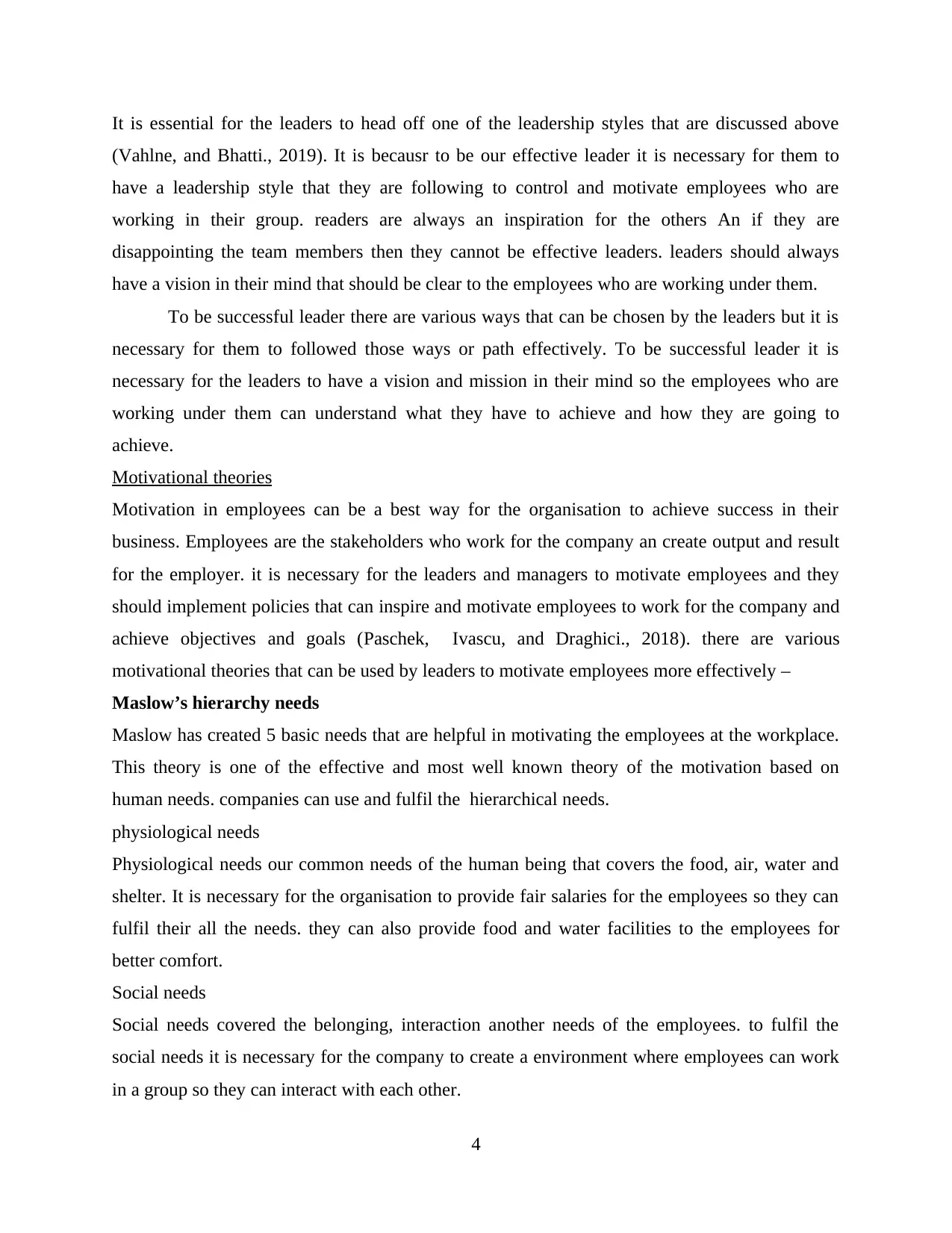
It is essential for the leaders to head off one of the leadership styles that are discussed above
(Vahlne, and Bhatti., 2019). It is becausr to be our effective leader it is necessary for them to
have a leadership style that they are following to control and motivate employees who are
working in their group. readers are always an inspiration for the others An if they are
disappointing the team members then they cannot be effective leaders. leaders should always
have a vision in their mind that should be clear to the employees who are working under them.
To be successful leader there are various ways that can be chosen by the leaders but it is
necessary for them to followed those ways or path effectively. To be successful leader it is
necessary for the leaders to have a vision and mission in their mind so the employees who are
working under them can understand what they have to achieve and how they are going to
achieve.
Motivational theories
Motivation in employees can be a best way for the organisation to achieve success in their
business. Employees are the stakeholders who work for the company an create output and result
for the employer. it is necessary for the leaders and managers to motivate employees and they
should implement policies that can inspire and motivate employees to work for the company and
achieve objectives and goals (Paschek, Ivascu, and Draghici., 2018). there are various
motivational theories that can be used by leaders to motivate employees more effectively –
Maslow’s hierarchy needs
Maslow has created 5 basic needs that are helpful in motivating the employees at the workplace.
This theory is one of the effective and most well known theory of the motivation based on
human needs. companies can use and fulfil the hierarchical needs.
physiological needs
Physiological needs our common needs of the human being that covers the food, air, water and
shelter. It is necessary for the organisation to provide fair salaries for the employees so they can
fulfil their all the needs. they can also provide food and water facilities to the employees for
better comfort.
Social needs
Social needs covered the belonging, interaction another needs of the employees. to fulfil the
social needs it is necessary for the company to create a environment where employees can work
in a group so they can interact with each other.
4
(Vahlne, and Bhatti., 2019). It is becausr to be our effective leader it is necessary for them to
have a leadership style that they are following to control and motivate employees who are
working in their group. readers are always an inspiration for the others An if they are
disappointing the team members then they cannot be effective leaders. leaders should always
have a vision in their mind that should be clear to the employees who are working under them.
To be successful leader there are various ways that can be chosen by the leaders but it is
necessary for them to followed those ways or path effectively. To be successful leader it is
necessary for the leaders to have a vision and mission in their mind so the employees who are
working under them can understand what they have to achieve and how they are going to
achieve.
Motivational theories
Motivation in employees can be a best way for the organisation to achieve success in their
business. Employees are the stakeholders who work for the company an create output and result
for the employer. it is necessary for the leaders and managers to motivate employees and they
should implement policies that can inspire and motivate employees to work for the company and
achieve objectives and goals (Paschek, Ivascu, and Draghici., 2018). there are various
motivational theories that can be used by leaders to motivate employees more effectively –
Maslow’s hierarchy needs
Maslow has created 5 basic needs that are helpful in motivating the employees at the workplace.
This theory is one of the effective and most well known theory of the motivation based on
human needs. companies can use and fulfil the hierarchical needs.
physiological needs
Physiological needs our common needs of the human being that covers the food, air, water and
shelter. It is necessary for the organisation to provide fair salaries for the employees so they can
fulfil their all the needs. they can also provide food and water facilities to the employees for
better comfort.
Social needs
Social needs covered the belonging, interaction another needs of the employees. to fulfil the
social needs it is necessary for the company to create a environment where employees can work
in a group so they can interact with each other.
4
Paraphrase This Document
Need a fresh take? Get an instant paraphrase of this document with our AI Paraphraser
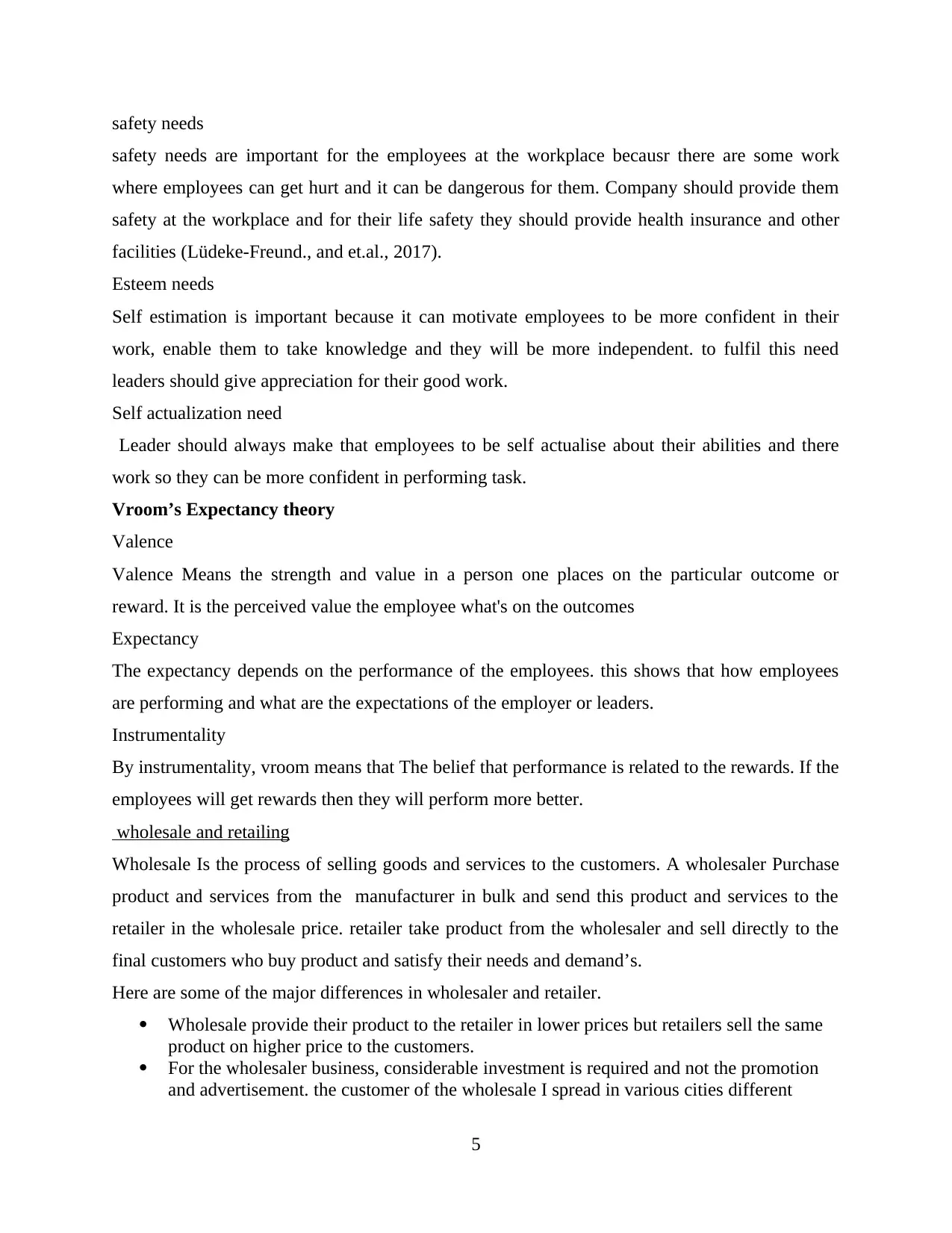
safety needs
safety needs are important for the employees at the workplace becausr there are some work
where employees can get hurt and it can be dangerous for them. Company should provide them
safety at the workplace and for their life safety they should provide health insurance and other
facilities (Lüdeke-Freund., and et.al., 2017).
Esteem needs
Self estimation is important because it can motivate employees to be more confident in their
work, enable them to take knowledge and they will be more independent. to fulfil this need
leaders should give appreciation for their good work.
Self actualization need
Leader should always make that employees to be self actualise about their abilities and there
work so they can be more confident in performing task.
Vroom’s Expectancy theory
Valence
Valence Means the strength and value in a person one places on the particular outcome or
reward. It is the perceived value the employee what's on the outcomes
Expectancy
The expectancy depends on the performance of the employees. this shows that how employees
are performing and what are the expectations of the employer or leaders.
Instrumentality
By instrumentality, vroom means that The belief that performance is related to the rewards. If the
employees will get rewards then they will perform more better.
wholesale and retailing
Wholesale Is the process of selling goods and services to the customers. A wholesaler Purchase
product and services from the manufacturer in bulk and send this product and services to the
retailer in the wholesale price. retailer take product from the wholesaler and sell directly to the
final customers who buy product and satisfy their needs and demand’s.
Here are some of the major differences in wholesaler and retailer.
Wholesale provide their product to the retailer in lower prices but retailers sell the same
product on higher price to the customers.
For the wholesaler business, considerable investment is required and not the promotion
and advertisement. the customer of the wholesale I spread in various cities different
5
safety needs are important for the employees at the workplace becausr there are some work
where employees can get hurt and it can be dangerous for them. Company should provide them
safety at the workplace and for their life safety they should provide health insurance and other
facilities (Lüdeke-Freund., and et.al., 2017).
Esteem needs
Self estimation is important because it can motivate employees to be more confident in their
work, enable them to take knowledge and they will be more independent. to fulfil this need
leaders should give appreciation for their good work.
Self actualization need
Leader should always make that employees to be self actualise about their abilities and there
work so they can be more confident in performing task.
Vroom’s Expectancy theory
Valence
Valence Means the strength and value in a person one places on the particular outcome or
reward. It is the perceived value the employee what's on the outcomes
Expectancy
The expectancy depends on the performance of the employees. this shows that how employees
are performing and what are the expectations of the employer or leaders.
Instrumentality
By instrumentality, vroom means that The belief that performance is related to the rewards. If the
employees will get rewards then they will perform more better.
wholesale and retailing
Wholesale Is the process of selling goods and services to the customers. A wholesaler Purchase
product and services from the manufacturer in bulk and send this product and services to the
retailer in the wholesale price. retailer take product from the wholesaler and sell directly to the
final customers who buy product and satisfy their needs and demand’s.
Here are some of the major differences in wholesaler and retailer.
Wholesale provide their product to the retailer in lower prices but retailers sell the same
product on higher price to the customers.
For the wholesaler business, considerable investment is required and not the promotion
and advertisement. the customer of the wholesale I spread in various cities different
5
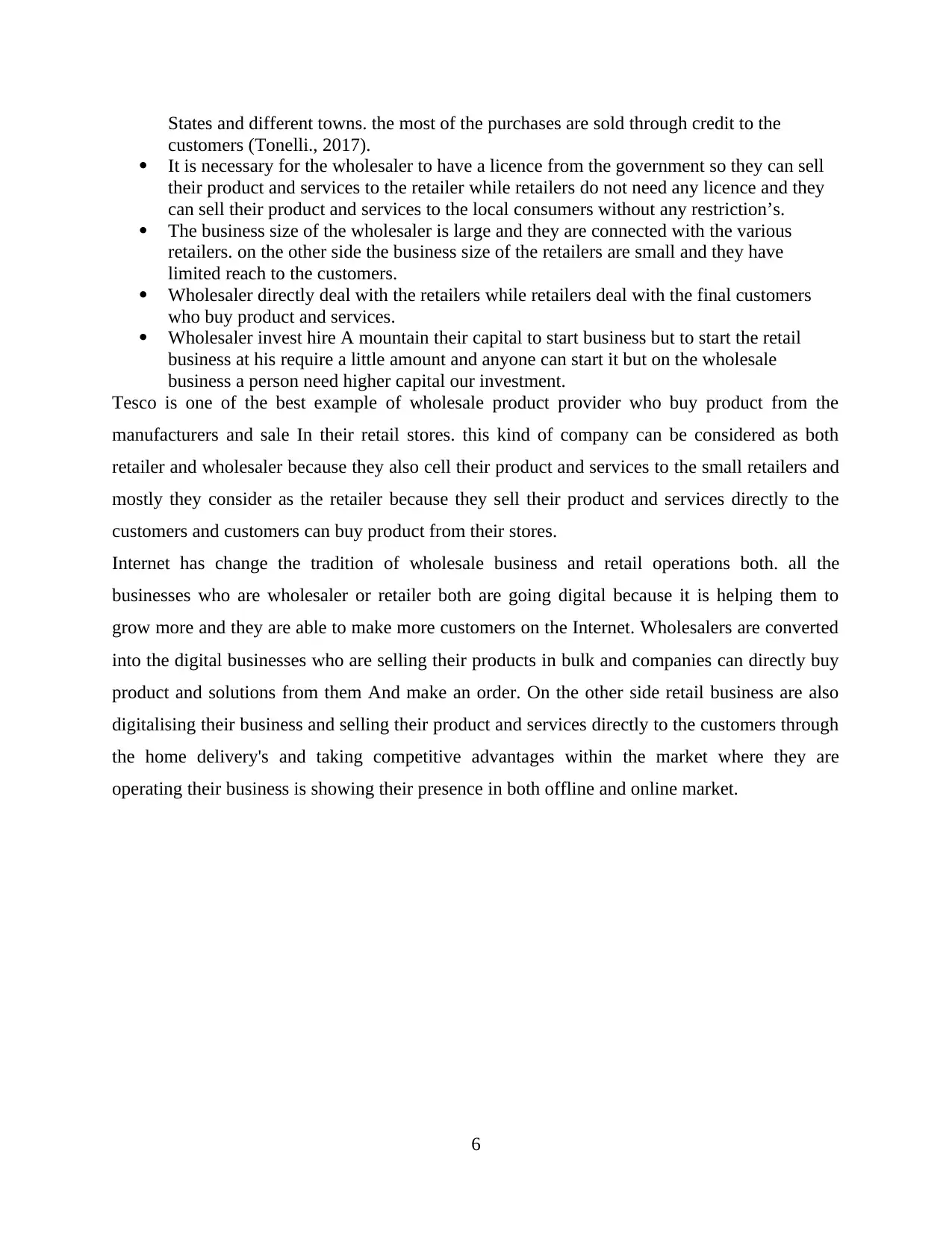
States and different towns. the most of the purchases are sold through credit to the
customers (Tonelli., 2017).
It is necessary for the wholesaler to have a licence from the government so they can sell
their product and services to the retailer while retailers do not need any licence and they
can sell their product and services to the local consumers without any restriction’s.
The business size of the wholesaler is large and they are connected with the various
retailers. on the other side the business size of the retailers are small and they have
limited reach to the customers.
Wholesaler directly deal with the retailers while retailers deal with the final customers
who buy product and services.
Wholesaler invest hire A mountain their capital to start business but to start the retail
business at his require a little amount and anyone can start it but on the wholesale
business a person need higher capital our investment.
Tesco is one of the best example of wholesale product provider who buy product from the
manufacturers and sale In their retail stores. this kind of company can be considered as both
retailer and wholesaler because they also cell their product and services to the small retailers and
mostly they consider as the retailer because they sell their product and services directly to the
customers and customers can buy product from their stores.
Internet has change the tradition of wholesale business and retail operations both. all the
businesses who are wholesaler or retailer both are going digital because it is helping them to
grow more and they are able to make more customers on the Internet. Wholesalers are converted
into the digital businesses who are selling their products in bulk and companies can directly buy
product and solutions from them And make an order. On the other side retail business are also
digitalising their business and selling their product and services directly to the customers through
the home delivery's and taking competitive advantages within the market where they are
operating their business is showing their presence in both offline and online market.
6
customers (Tonelli., 2017).
It is necessary for the wholesaler to have a licence from the government so they can sell
their product and services to the retailer while retailers do not need any licence and they
can sell their product and services to the local consumers without any restriction’s.
The business size of the wholesaler is large and they are connected with the various
retailers. on the other side the business size of the retailers are small and they have
limited reach to the customers.
Wholesaler directly deal with the retailers while retailers deal with the final customers
who buy product and services.
Wholesaler invest hire A mountain their capital to start business but to start the retail
business at his require a little amount and anyone can start it but on the wholesale
business a person need higher capital our investment.
Tesco is one of the best example of wholesale product provider who buy product from the
manufacturers and sale In their retail stores. this kind of company can be considered as both
retailer and wholesaler because they also cell their product and services to the small retailers and
mostly they consider as the retailer because they sell their product and services directly to the
customers and customers can buy product from their stores.
Internet has change the tradition of wholesale business and retail operations both. all the
businesses who are wholesaler or retailer both are going digital because it is helping them to
grow more and they are able to make more customers on the Internet. Wholesalers are converted
into the digital businesses who are selling their products in bulk and companies can directly buy
product and solutions from them And make an order. On the other side retail business are also
digitalising their business and selling their product and services directly to the customers through
the home delivery's and taking competitive advantages within the market where they are
operating their business is showing their presence in both offline and online market.
6
⊘ This is a preview!⊘
Do you want full access?
Subscribe today to unlock all pages.

Trusted by 1+ million students worldwide
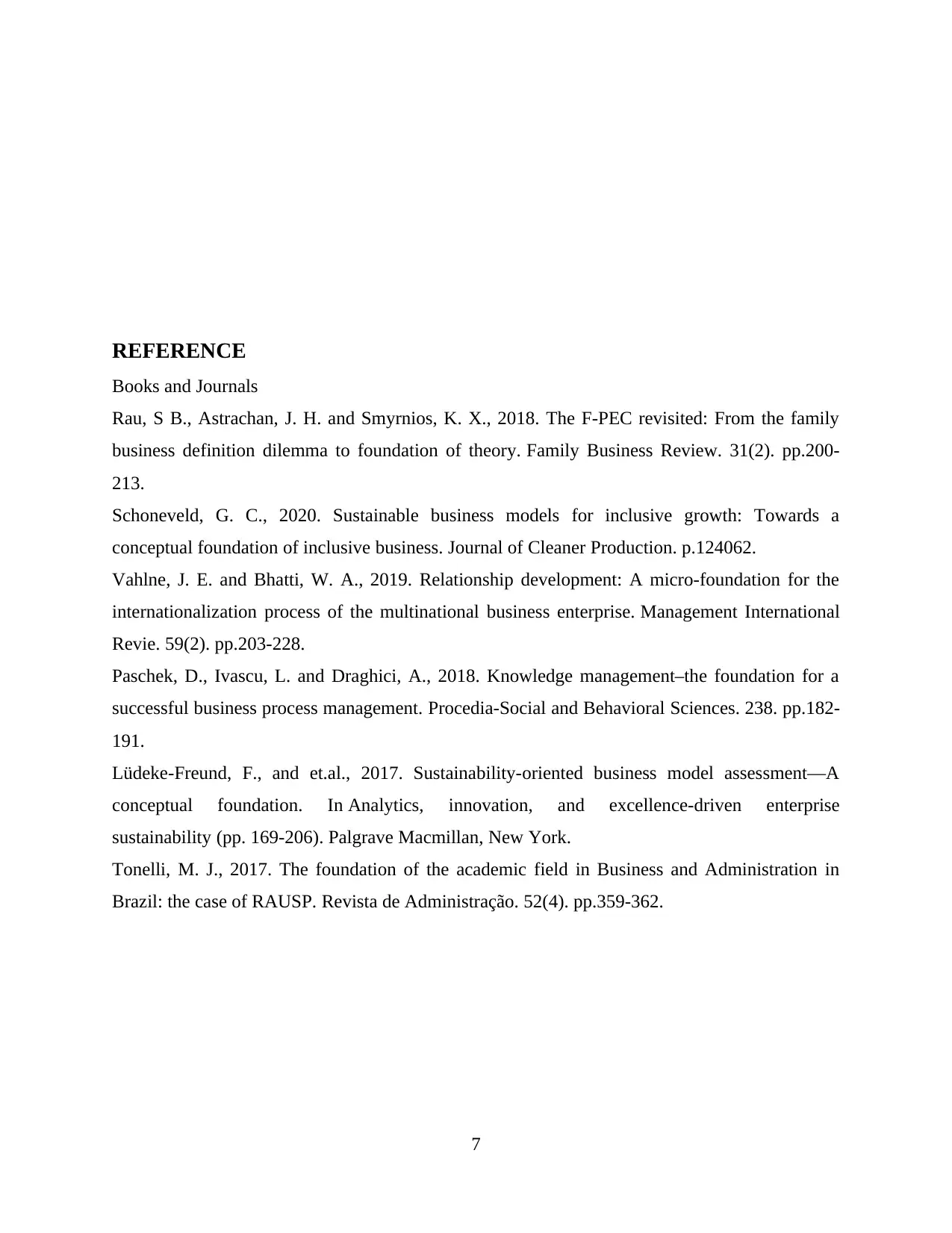
REFERENCE
Books and Journals
Rau, S B., Astrachan, J. H. and Smyrnios, K. X., 2018. The F-PEC revisited: From the family
business definition dilemma to foundation of theory. Family Business Review. 31(2). pp.200-
213.
Schoneveld, G. C., 2020. Sustainable business models for inclusive growth: Towards a
conceptual foundation of inclusive business. Journal of Cleaner Production. p.124062.
Vahlne, J. E. and Bhatti, W. A., 2019. Relationship development: A micro-foundation for the
internationalization process of the multinational business enterprise. Management International
Revie. 59(2). pp.203-228.
Paschek, D., Ivascu, L. and Draghici, A., 2018. Knowledge management–the foundation for a
successful business process management. Procedia-Social and Behavioral Sciences. 238. pp.182-
191.
Lüdeke-Freund, F., and et.al., 2017. Sustainability-oriented business model assessment—A
conceptual foundation. In Analytics, innovation, and excellence-driven enterprise
sustainability (pp. 169-206). Palgrave Macmillan, New York.
Tonelli, M. J., 2017. The foundation of the academic field in Business and Administration in
Brazil: the case of RAUSP. Revista de Administração. 52(4). pp.359-362.
7
Books and Journals
Rau, S B., Astrachan, J. H. and Smyrnios, K. X., 2018. The F-PEC revisited: From the family
business definition dilemma to foundation of theory. Family Business Review. 31(2). pp.200-
213.
Schoneveld, G. C., 2020. Sustainable business models for inclusive growth: Towards a
conceptual foundation of inclusive business. Journal of Cleaner Production. p.124062.
Vahlne, J. E. and Bhatti, W. A., 2019. Relationship development: A micro-foundation for the
internationalization process of the multinational business enterprise. Management International
Revie. 59(2). pp.203-228.
Paschek, D., Ivascu, L. and Draghici, A., 2018. Knowledge management–the foundation for a
successful business process management. Procedia-Social and Behavioral Sciences. 238. pp.182-
191.
Lüdeke-Freund, F., and et.al., 2017. Sustainability-oriented business model assessment—A
conceptual foundation. In Analytics, innovation, and excellence-driven enterprise
sustainability (pp. 169-206). Palgrave Macmillan, New York.
Tonelli, M. J., 2017. The foundation of the academic field in Business and Administration in
Brazil: the case of RAUSP. Revista de Administração. 52(4). pp.359-362.
7
1 out of 7
Related Documents
Your All-in-One AI-Powered Toolkit for Academic Success.
+13062052269
info@desklib.com
Available 24*7 on WhatsApp / Email
![[object Object]](/_next/static/media/star-bottom.7253800d.svg)
Unlock your academic potential
Copyright © 2020–2025 A2Z Services. All Rights Reserved. Developed and managed by ZUCOL.



